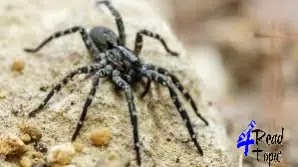Wolf Spider
- Information about wolf spiders:
The wolf spider is a carnivorous spider family that has adapted to almost every major environment on the planet. Among its many interesting and distinctive characteristics, most wolf spiders cannot spin intricate webs to catch prey.
Instead, they chase their victims as ruthlessly as the renowned animal after which they are named. Females also carry their young on their backs. Wolf spiders, despite their scary appearance and behavior, are an important element of the food chain because they assist to keep many other bug species in check.
- The scientific name of the wolf spider:
Lycosidae is the scientific name for the wolf spider, which is derived from the ancient Greek word for wolf. There are around 124 genera and over 2,800 species in this enormous family (depending on how they are classified). Since there are so many different species, it is difficult to give a complete overview of the varieties, but nevertheless, there are many similarities between them. This family belongs to the order Araneae, which includes all known spiders.
- Wolf spider appearance and behavior:
The wolf spider can sometimes be recognized by its large eyes, long legs, massive body, and massive appendages. It has black, brown, or gray colors sometimes mixed with light tan or orange markings. This enables them to blend in with their surroundings and catch their prey off guard.
The wolf spider has eight eyes located around its head in three distinct rows: two on top, two in front, and four other eyes above the mouth. These four smaller eyes provide secondary vision and contain a type of reflective tissue that can produce strong glare in light. A wolf spider's body size can vary greatly between 0.24 and 1.2 inches - or about the size of a coin - and they usually weigh less than an ounce.
Its eight legs are much longer than the body and make the spider appear larger than it actually is. On average, females are larger than males. Wolf spiders are nocturnal creatures that only prey at night. They spend most of the time on the ground, but sometimes climb trees or plants to catch prey.
- home of spider wolf:
The wolf spider is a really prolific family that can live almost anywhere in the world besides the extreme arctic and Antarctic. Its habitat extends across almost the entire world, including much of the Sahara and Siberia.
Grasslands, meadows, bushes, woodlands, wetlands, gardens, and human houses are the most common ecosystems. They can also live in inhospitable places such as deserts, mountains, and even volcanoes.
While certain species require particularly specialized weather parameters, the overwhelming majority have evolved to thrive in a wide range of environments. In the United States, there are about 200 different species of wolf spiders.
The rabid wolf spider is among the most common species. They are found throughout Texas, Oklahoma, and sometimes even Maine and Florida. The furious wolf spider, despite its moniker, is not particularly deadly.
- Wolf spider: reproduction, children, and age:
At the beginning of the mating season, male spiders will attempt to court the females by waving their feet (their mouth appendages) in the air or beating them together. Wolf spiders are selective in mate selection and look for specific characteristics that may be unique to each species. It is also thought that a male may be able to sense sexual availability and even a female's prior sexual behavior from the chemical makeup of her silk.
In courtship, males must strike a balance between being bold yet not aggressive. In a small minority of mating encounters, the female may tend to eat the male. This can sometimes happen before they have successfully mated if the confrontation goes wrong. It has also been documented that males can eat older females of lower reproductive value, but this situation is much rarer than the other way around.
Whether the male survives the encounter or not, the female is left alone to lay dozens of eggs and take on most of the child-rearing duties. The fact that the female wolf spider wraps the eggs in silk and carries the egg sac around her abdomen is one of the spider's numerous unique characteristics. After hatching, the newborn spiders will emerge from the bag and climb onto the mother's back for the rest of her life.
After several weeks, the young spiders will be large enough to survive on their own. They are the only species of spider known to carry their young on their backs. The majority of wolf spiders survive for a year, while some might live for up to two years. Due to their limited lifespan, wolf spiders must generate as many babies as possible before dying. Many of these offspring are killed early and do not live long enough to mate. For this reason, spiders prefer to breed in large quantities.
- wolf spider numbers:
Conservationists consider that most wolf spider species are not seriously threatened. Their tremendous adaptability has made them one of the most successful animals on the planet thanks to their wide distribution and stable population numbers. This rule does, however, have a few exceptions. According to =(IUCN) Red List, some species found on small islands such as Deserts and Saint Helena are critically endangered. Many other species are either endangered or endangered. Due to the huge number of species, many of which are very rare and remote, it is difficult to track and preserve them all. The exact population numbers are not fully known.
- wolf spider diet:
The diet of the wolf spider is almost entirely made up of insects and other spiders. Less commonly they take refuge in small reptiles and amphibians. Some of her favorite foods are ants, grasshoppers, and beetles, but the diet can vary greatly depending on the climate and location. This varied diet enables them to live almost anywhere small invertebrates are found. The wolf spider is a lightning-fast predator. Several species are waiting in hiding to surprise and pounce on their prey from a distance. They are also fast enough to chase retreating prey.
The spider then begins to coil the prey into a ball or inject poison directly into its body to liquefy its organs once it has been caught. Then the spider absorbs the liquid nutrients from the body. Wolf spiders have a few techniques for dealing with scarcity of food, especially in hostile areas where they may be deprived regularly. They can slow down the metabolism or they can participate in some cannibalism.
- Vision and predation:
To seek prey and evade predators, the wolf spider uses its exceptional vision and sensitivity to ambient vibrations. They also make sounds and emit contact chemicals. Wolf spiders can be territorial or itinerant. Some species dig holes under rocks, logs, or other objects for safety and security and then cover the hole with debris or trash. They tend to have a specific hunting ground that they will return to every night. Other wolf spiders do not have a definite home.
They roam around a wide swath of land in search of food and may seek human habitation when the weather turns cold. Although related to web-building spiders, the wolf spider does not build large webs, but it still produces silk for egg sacs and other purposes. Thus, their silk has a slightly different composition and strength compared to web-building spiders. Because they lack this skill, their foraging behavior is more like that of a carnivore like a wolf than many other spider species. Wolf spider (Lycosidae) wolf spider with children
- Wolf spider: predators and threats:
Despite its frightening nature, the wolf spider is a common food for larger creatures such as birds, lizards, and rodents due to its small size. When confronted by a predator, the wolf spider has numerous defenses at its disposal. He has a remarkable ability to separate a leg and make a daring escape (the spider later regenerates his leg, but usually at a short-term cost). A poisonous sting is also a painful deterrent to many predators. If all else fails, the spider will try to use its impressive speed and agility to run and hide.
Unlike many other animals, humans are only a minimal threat to the wolf spider family as a whole. They are well adapted to human habitats and can even coexist with people when left alone. However, due to the fear of spiders, people often try to kill them.
- Frequently asked questions about wolf spiders:
Wolf spiders are recognizable by their large mouthparts, muted colors, and large, round eyes. The bigger species of wolf spiders are occasionally confused with tarantulas due to their similar appearance, however, the two families are not related.
Humans are not particularly vulnerable to the venom of wolf spiders. Even if you were a little bit, the poison wouldn't produce anything more serious than slight redness, itching, and swelling. There is significant controversy over whether wolf spider bites can spread dangerous bacteria that can infect portions of the skin. These occurrences, however, are uncommon and have not been definitely connected to the wolf spider. There have been no additional significant complications reported.
Although many people are afraid of huge spiders, wolf spiders are an integral element of the ecology. They feed on insects that many people consider pests. Many of these insects can destroy beneficial crops and plants.
Since they primarily eat insects and other spiders, wolf spiders are carnivores. Unlike many other spiders, they hunt their prey rather than catching it in a web.
The evolution of the wolf spider is not fully understood, but the first spiders are thought to have likely evolved over 350 million years ago — around the same time Mammals, reptiles, and other terrestrial animals descended from them. The wolf spider group is one of the world's oldest spider families, having descended from web-spinning spiders tens of millions or even a hundred million years ago.
Wolf spiders are omnivores, which means they eat plants and other animals.
Wolf spiders belong to the animal kingdom.
Wolf spiders belong to the family of arthropods.
Wolf spiders belong to the class Arachnida.
Wolf spiders belong to the family Lycosidae.
Wolf spiders belong to the order Araneae.
Wolf spiders are covered with hair.
Wolf spiders live on all continents besides Antarctica.
Forests, grasslands, deserts, and marshes are all home to wolf spiders.
The predators of wolf spiders include birds, reptiles, and rodents.
The wolf spider is a carnivorous spider that hunts its prey.
Wolf spiders can live for one to two years.









Comments
Post a Comment
You can write your comment here